The Point-of-Care Opioid Testing Market is estimated to be valued at USD 496.2 billion in 2025 and is projected to reach USD 782.0 billion by 2035, registering a compound annual growth rate (CAGR) of 4.7% over the forecast period.
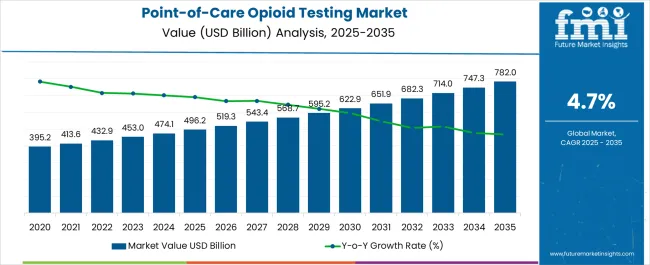
| Metric | Value |
|---|---|
| Point-of-Care Opioid Testing Market Estimated Value in (2025 E) | USD 496.2 billion |
| Point-of-Care Opioid Testing Market Forecast Value in (2035 F) | USD 782.0 billion |
| Forecast CAGR (2025 to 2035) | 4.7% |
The point of care opioid testing market is witnessing consistent expansion driven by the rising prevalence of opioid misuse, growing focus on rapid diagnosis, and increasing adoption of decentralized testing solutions in both clinical and non clinical environments. The ability to deliver immediate results without the need for advanced laboratory infrastructure has strengthened adoption across emergency care, law enforcement, rehabilitation centers, and workplace testing programs.
Technological advances in lateral flow assays, digital integration, and portable analyzers are enhancing the accuracy and usability of these tests. Regulatory initiatives aimed at curbing the opioid crisis are further promoting adoption through funding and awareness programs.
The market outlook remains positive as demand for fast, reliable, and scalable solutions grows in alignment with public health strategies and regulatory mandates addressing the opioid epidemic.
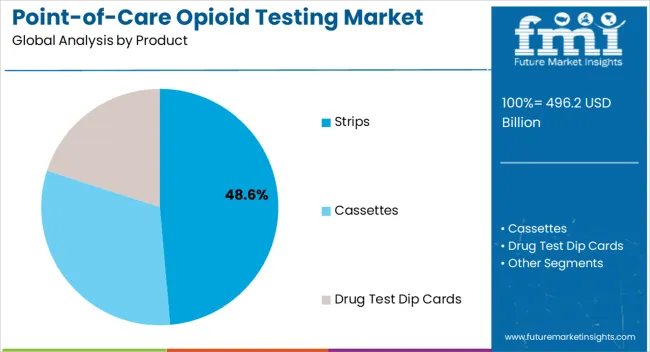
The strips segment is projected to account for 48.60% of total revenue by 2025 within the product category, establishing it as a leading segment. This dominance is supported by their cost effectiveness, ease of use, and rapid result generation.
Strips are particularly suitable for large scale screening initiatives and home based applications, where affordability and accessibility are critical. Their compatibility with multiple biological samples and minimal training requirements has also contributed to their strong market share.
As healthcare providers and community programs seek affordable diagnostic solutions, strips continue to serve as a reliable option for immediate opioid detection.
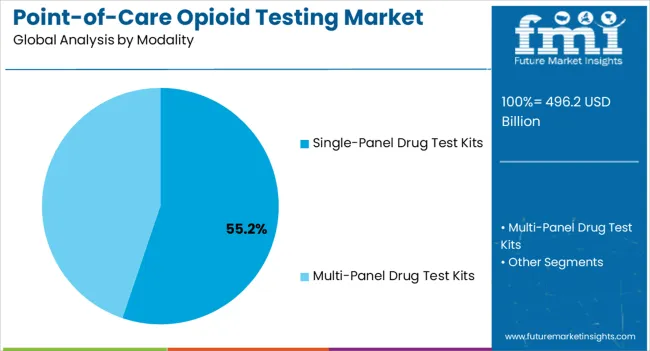
The single panel drug test kits segment is expected to contribute 55.20% of total market revenue by 2025, making it the leading modality. This prominence is attributed to their simplicity, accuracy, and ability to provide rapid results for a specific drug of concern.
Their focused approach has been valuable in high risk environments such as emergency response and law enforcement, where immediate decisions are necessary. Cost efficiency and faster processing compared to multi panel kits have supported widespread adoption.
The segment’s growth is further reinforced by their scalability in both clinical and non clinical use cases, cementing their leadership in the modality category.
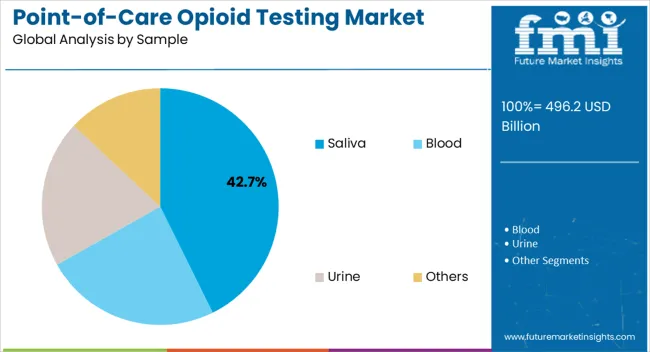
The saliva sample segment is projected to account for 42.70% of market revenue by 2025, positioning it as the leading sample type. Saliva based testing has gained preference due to its non invasive nature, ease of collection, and reduced risk of adulteration compared to urine samples.
Its suitability for roadside testing, workplace monitoring, and home based screening has increased demand significantly. Advances in assay sensitivity for saliva samples have also improved reliability, making them a trusted option for opioid detection.
With growing emphasis on user friendly and tamper resistant testing methods, the saliva segment continues to dominate in the point of care opioid testing market.
From 2020 to 2025, the global point-of-care opioid testing market experienced a CAGR of 3.9%, reaching a market size of USD 496.2 million in 2025.
From 2020 to 2025, the global point-of-care opioid testing industry witnessed significant growth as advancements in testing technologies have significantly contributed to the historic growth of the market.
The development of point-of-care testing with improved accuracy, sensitivity, and speed has facilitated rapid screening and early detection of opioid use. These technological advancements have enhanced the convenience and accessibility of testing, leading to increased adoption and market growth.
Future Forecast for Point-of-Care Opioid Testing Market Industry:
Looking ahead, the global point-of-care opioid testing market industry is expected to rise at a CAGR of 4.9% from 2025 to 2035. During the forecast period, the market size is expected to reach USD 782 million by 2035.
The point-of-care opioid testing industry is expected to continue its growth trajectory from 2025 to 2035, driven by increasing emphasis on patient-centered care and remote monitoring, there will be a growing demand for convenient and accessible testing options that can be performed in the comfort of one's home.
Home-based testing kits and connected devices will empower individuals to monitor their opioid use, promote self-management, and facilitate remote consultations with healthcare providers.
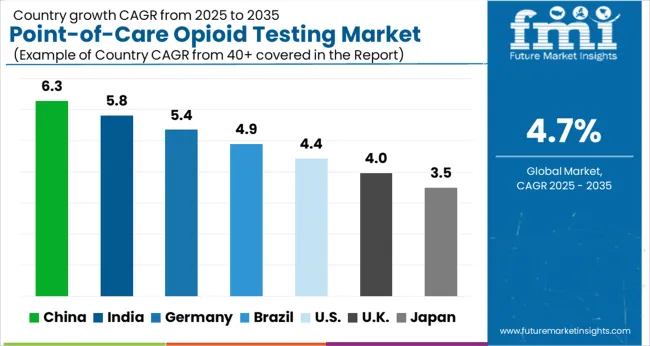
| Country | The United States |
|---|---|
| Market Size (USD million) by End of Forecast Period (2035) | USD 782 million |
| CAGR % 2025 to End of Forecast (2035) | 4.2% |
The point-of-care opioid testing industry in the United States is expected to reach a market size of USD 782 million by 2035, expanding at a CAGR of 4.2%. The opioid crisis remains a significant driver of the point-of-care opioid testing market in the United States.
The increasing prevalence of opioid misuse and addiction has prompted healthcare providers, policymakers, and stakeholders to prioritize interventions and strategies to combat the crisis. Point-of-care opioid testing plays a crucial role in identifying opioid use, enabling early intervention, and monitoring treatment progress.
| Country | The United Kingdom |
|---|---|
| Market Size (USD million) by End of Forecast Period (2035) | USD 32.0 million |
| CAGR % 2025 to End of Forecast (2035) | 4.3% |
The point-of-care opioid testing industry in the United Kingdom is expected to reach a market value of USD 32.0 million, expanding at a CAGR of 4.3% during the forecast period. Recent advancements in testing technologies have influenced the point-of-care opioid testing market in the UK.
These advancements include the development of more accurate, sensitive, and user-friendly testing devices. Point-of-care opioid testing technologies, such as immunoassays, oral fluid tests, and urine tests, have become more reliable and accessible, supporting wider adoption in various healthcare settings.
| Country | China |
|---|---|
| Market Size (USD million) by End of Forecast Period (2035) | USD 54.7 million |
| CAGR % 2025 to End of Forecast (2035) | 6.4% |
The point-of-care opioid testing industry in China is anticipated to reach a market size of USD 54.7 million, moving at a CAGR of 6.4% during the forecast period. The Chinese government has implemented initiatives and policies to combat substance abuse and improve public health outcomes.
These initiatives include strengthening regulations on opioid medications, establishing rehabilitation centers, and promoting the use of point-of-care opioid testing in healthcare facilities. Government support and policies have been crucial drivers for the adoption and growth of the point-of-care opioid testing market in China.
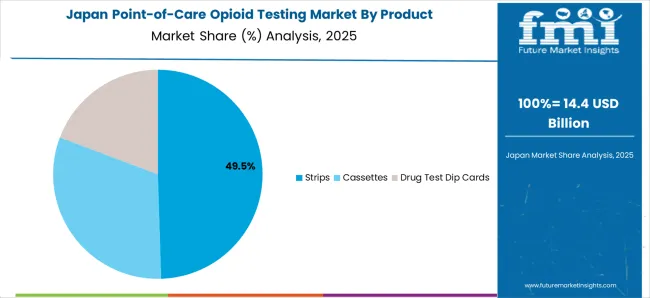
| Country | Japan |
|---|---|
| Market Size (USD million) by End of Forecast Period (2035) | USD 39.9 million |
| CAGR % 2025 to End of Forecast (2035) | 6.2% |
The point-of-care opioid testing industry in Japan is estimated to reach a market size of USD 39.9 million by 2035, thriving at a CAGR of 6.2%. Japan has seen increased research and development efforts in the field of point-of-care opioid testing. Academic institutions, research organizations, and healthcare companies are investing in the development of innovative testing methodologies, biomarkers, and data analysis algorithms.
This driver fosters continuous innovation, advancements in testing technologies, and the potential for personalized medicine approaches in opioid addiction management.
| Country | South Korea |
|---|---|
| Market Size (USD million) by End of Forecast Period (2035) | USD 45.4 million |
| CAGR % 2025 to End of Forecast (2035) | 6.0% |
The point-of-care opioid testing industry in South Korea is expected to reach a market size of USD 45.4 million, expanding at a CAGR of 6.0% during the forecast period. The South Korean government has implemented stricter regulations and monitoring measures for opioid medications.
These regulations aim to prevent misuse, addiction, and illegal distribution of opioids. The increased focus on monitoring drives the adoption of point-of-care opioid testing as a tool to ensure compliance with regulations and enhance patient safety.
Test strips are expected to dominate the point-of-care opioid testing industry with a CAGR of 4.7% from 2025 to 2035. Test strips are available for different sample types, including urine, saliva, and blood.
Urine is the most commonly used sample type for point-of-care opioid testing due to its ease of collection and high concentration of detectable substances. Saliva and blood samples may also be used in certain situations, such as in clinical laboratory settings or for specific testing requirements.
Multi-panel drug test kits are expected to dominate the point-of-care opioid testing industry with a CAGR of 5.2% from 2025 to 2035. Multi-panel kits allow for simultaneous testing of multiple drugs within a single device. Each drug panel on the test kit contains specific reagents or antibodies that react with the targeted drugs or their metabolites. When the sample is applied to the kit, it flows through the different panels, and if any of the targeted drugs are present, corresponding lines or color changes appear on the test result window.
Blood sample are expected to dominate the point-of-care opioid testing industry with a CAGR of 4.9% from 2025 to 2035. Blood samples provide a higher level of sensitivity and specificity compared to urine and saliva samples. The concentration of opioids and their metabolites in blood is generally higher and offers a more accurate representation of recent drug use. This makes blood testing particularly valuable in cases where precise quantification and detection of specific opioid compounds are required.
Forensic Laboratories is expected to dominate the point-of-care opioid testing industry with a CAGR of 5.4% from 2025 to 2035. Forensic laboratories play a crucial role in confirming preliminary point-of-care test results.
Point-of-care tests provide rapid screening but may have limitations in terms of sensitivity and specificity. Forensic laboratories perform confirmatory testing to validate the presence of opioids and determine the precise concentration or level of opioids in a sample. This information is essential for legal proceedings, workplace incidents, and clinical decision-making.
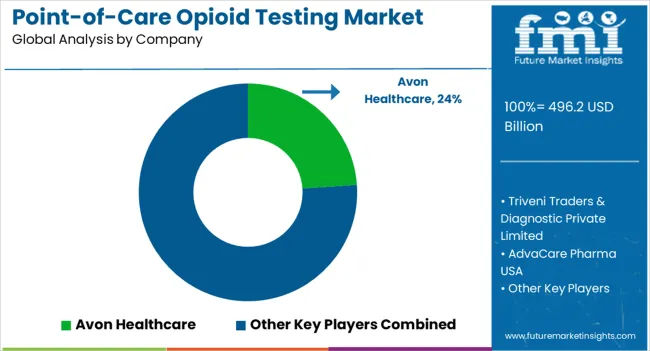
The point-of-care opioid testing market is fiercely competitive, with many companies fighting for market dominance. To stay ahead of the competition in such a circumstance, essential players must develop effective conjugates.
Key Strategies Used by the Participants
Product Development
Companies are investing in research & development to deliver product that improve efficiency, dependability, and cost-effectiveness. Product innovation allows businesses to differentiate themselves from their competition while also catering to the changing demands of their clients.
Strategic Alliances & Collaborations
Key industry leaders frequently develop strategic partnerships and collaborations with other companies in order to harness their strengths and increase their market reach. Companies might also gain access to new technology and markets through such agreements.
Expansion into Emerging Markets
The point-of-care opioid testing market is expanding rapidly in emerging regions such as China and India. Key firms are enhancing their distribution networks and developing local manufacturing facilities to increase their presence in these areas.
Acquisitions and mergers
Mergers and acquisitions are frequently used by key players in the point-of-care opioid testing industry to consolidate their market position, extend their product range, and gain access to new markets.
Key Developments in the Point-of-care opioid testing Market:
The global point-of-care opioid testing market is estimated to be valued at USD 496.2 billion in 2025.
The market size for the point-of-care opioid testing market is projected to reach USD 782.0 billion by 2035.
The point-of-care opioid testing market is expected to grow at a 4.7% CAGR between 2025 and 2035.
The key product types in point-of-care opioid testing market are strips, cassettes and drug test dip cards.
In terms of modality, single-panel drug test kits segment to command 55.2% share in the point-of-care opioid testing market in 2025.






Our Research Products

The "Full Research Suite" delivers actionable market intel, deep dives on markets or technologies, so clients act faster, cut risk, and unlock growth.

The Leaderboard benchmarks and ranks top vendors, classifying them as Established Leaders, Leading Challengers, or Disruptors & Challengers.

Locates where complements amplify value and substitutes erode it, forecasting net impact by horizon

We deliver granular, decision-grade intel: market sizing, 5-year forecasts, pricing, adoption, usage, revenue, and operational KPIs—plus competitor tracking, regulation, and value chains—across 60 countries broadly.

Spot the shifts before they hit your P&L. We track inflection points, adoption curves, pricing moves, and ecosystem plays to show where demand is heading, why it is changing, and what to do next across high-growth markets and disruptive tech

Real-time reads of user behavior. We track shifting priorities, perceptions of today’s and next-gen services, and provider experience, then pace how fast tech moves from trial to adoption, blending buyer, consumer, and channel inputs with social signals (#WhySwitch, #UX).

Partner with our analyst team to build a custom report designed around your business priorities. From analysing market trends to assessing competitors or crafting bespoke datasets, we tailor insights to your needs.
Supplier Intelligence
Discovery & Profiling
Capacity & Footprint
Performance & Risk
Compliance & Governance
Commercial Readiness
Who Supplies Whom
Scorecards & Shortlists
Playbooks & Docs
Category Intelligence
Definition & Scope
Demand & Use Cases
Cost Drivers
Market Structure
Supply Chain Map
Trade & Policy
Operating Norms
Deliverables
Buyer Intelligence
Account Basics
Spend & Scope
Procurement Model
Vendor Requirements
Terms & Policies
Entry Strategy
Pain Points & Triggers
Outputs
Pricing Analysis
Benchmarks
Trends
Should-Cost
Indexation
Landed Cost
Commercial Terms
Deliverables
Brand Analysis
Positioning & Value Prop
Share & Presence
Customer Evidence
Go-to-Market
Digital & Reputation
Compliance & Trust
KPIs & Gaps
Outputs
Full Research Suite comprises of:
Market outlook & trends analysis
Interviews & case studies
Strategic recommendations
Vendor profiles & capabilities analysis
5-year forecasts
8 regions and 60+ country-level data splits
Market segment data splits
12 months of continuous data updates
DELIVERED AS:
PDF EXCEL ONLINE
Point-Of-Care Genetic Testing Market
Point-of-Care Food Sensitivity Testing Market Size and Share Forecast Outlook 2025 to 2035
Network Point-of-Care Glucose Testing Market Size and Share Forecast Outlook 2025 to 2035
Opioid Withdrawal Management Market Size and Share Forecast Outlook 2025 to 2035
Opioid-Induced Constipation (OIC) Treatment Market Size and Share Forecast Outlook 2025 to 2035
Opioid Use Disorder Treatment Industry Analysis by Opioid Antagonists and Opioid Agonists and Partial Agonists through 2035
Opioid Analgesics Market Analysis - Size, Share, and Forecast 2025 to 2035
Market Positioning & Share in the Opioid Use Disorder Treatment Sector
Opioid-Induced Respiratory Depression Market
Non-opioid Pain Patches Market Size and Share Forecast Outlook 2025 to 2035
Market Share Distribution Among Opioid Use Disorder Treatment Providers in Europe
Global Acetaminophen-Opioid Combination Market Analysis – Size, Share & Forecast 2024-2034
Australia & NZ Opioid Use Disorder Treatment Market Analysis – Size, Share & Forecast 2025-2035
Low and Middle Income Countries Opioid Substitution Therapy Market Analysis by Drug Class, Indication, Distribution Channel, and Region through 2025 to 2035
Testing, Inspection & Certification Market Growth – Trends & Forecast 2025 to 2035
5G Testing Market Size and Share Forecast Outlook 2025 to 2035
AB Testing Software Market Size and Share Forecast Outlook 2025 to 2035
5G Testing Equipment Market Analysis - Size, Growth, and Forecast 2025 to 2035
Eye Testing Equipment Market Size and Share Forecast Outlook 2025 to 2035
HSV Testing Market Size and Share Forecast Outlook 2025 to 2035

Thank you!
You will receive an email from our Business Development Manager. Please be sure to check your SPAM/JUNK folder too.
Chat With
MaRIA